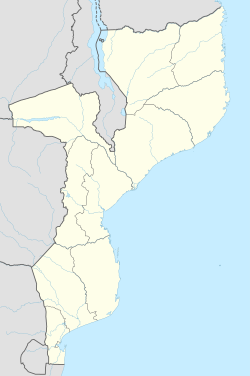
Niassa is a province of Mozambique. It has an area of 129,056 km2 and a population of 1,810,794 (2017). It is the most sparsely populated province in the country. Lichinga is the capital of the province. There are a minimum estimated 450,000 Yao people living in Mozambique. They largely occupy the eastern and northern part of the Niassa province and form about 40% of the population of Lichinga, the capital of this province.
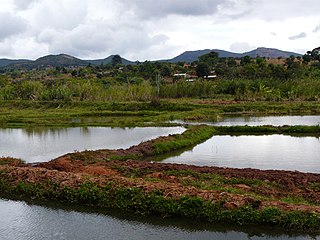
Ruvuma Region is one of Tanzania's 31 administrative regions. The regional capital is the municipality of Songea. According to the 2012 national census, the region had a population of 1,376,891, which was lower than the pre-census projection of 1,449,830. For 2002–2012, the region's 2.1 percent average annual population growth rate was the twentieth highest in the country. It was also the 28th most densely populated region with 22 inhabitants per square kilometre (57/sq mi).
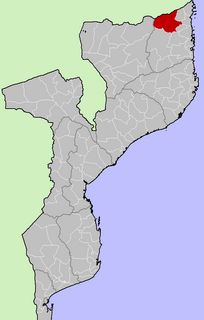
Mueda is a district of the province of Cabo Delgado, in Moçambique. The capital is the town of Mueda.

Songea is the capital of Ruvuma Region in southwestern Tanzania. It is located along the A19 road. The city has a population of approximately 203,309, and it is the seat of the Roman Catholic Archdiocese of Songea. Between 1905 and 1907, the city was a centre of African resistance during the Maji Maji Rebellion in German East Africa. The city is poised to experience significant economic growth in the near future as the Mtwara Corridor opens up in a few years. Projected to be the sixth fastest growing city on the African continent between 2020 and 2025, with a 5.74% growth.

Ruvuma River, formerly also known as the Rovuma River, is a river in the African Great Lakes region. During the greater part of its course, it forms the border between Tanzania and Mozambique. The river is 800 kilometres (497 mi) long, with a drainage basin of 155,500 square kilometres (60,000 sq mi) in size. Its mean annual discharge is 475 m³/s at its mouth.
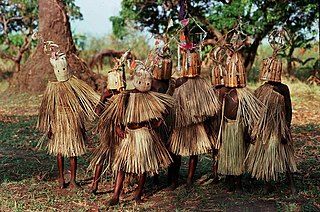
The Yao people, waYao, are a major Bantu ethnic and linguistic group based at the southern end of Lake Malawi, who played an important part in the history of Southeast Africa during the 19th century. The Yao are a predominantly Muslim people of about 2 million spread over three countries, Malawi, northern Mozambique, and in Ruvuma Region and Mtwara Region of Tanzania. The Yao people have a strong cultural identity, which transcends the national borders.

The Niassa Company or Nyassa Chartered Company was a royal company in the Portuguese colony of Mozambique, then known as Portuguese East Africa, that had the concession of the lands that include the present provinces of Cabo Delgado and Niassa between 1891 and 1929.
Those interested in the subject can monitor changes to the pages by clicking on Related changes in the sidebar. Articles related to Tanzania include:
Yao is a Bantu language in Africa with approximately two million speakers in Malawi, and half a million each in Tanzania and Mozambique. There are also some speakers in Zambia. In Malawi, the main dialect is Mangochi, mostly spoken around Lake Malawi. In Mozambique, the main dialects are Makale and Massaninga. The language has also gone by several other names in English, including chiYao or ciYao, Achawa, Adsawa, Adsoa, Ajawa, Ayawa, Ayo, Ayao, Djao, Haiao, Hiao, Hyao, Jao, Veiao, and waJao.

The Unity Bridge across Ruvuma River at Negomano, Mozambique, between Tanzania and Mozambique, was proposed as early as 1975, shortly after Mozambique's independence. It was the idea of the two countries' former Presidents, Mwalimu Nyerere and Samora Machel. Several design studies and limited construction work were completed in the early 1980s, but the Unity Bridge was not finished due to lack of funds.

Niassa Reserve is a nature reserve in Cabo Delgado Province and Niassa Province, Mozambique. Covering over 42,000 square kilometres, it is the largest protected area in the country. The reserve is part of the Trans-Frontier Conservation Area and links to the Tanzanian Lukwika-Lumesule Game Reserve. It will connect to the Lake Niassa Reserve when it is completed.

The following outline is provided as an overview of and topical guide to Tanzania:

The Battle of Ngomano or Negomano was fought between Germany and Portugal during the East African Campaign of World War I. A force of Germans and Askaris under Paul Emil von Lettow-Vorbeck had recently won a costly victory against the British at the Battle of Mahiwa, in present-day Tanzania and ran very short of food and other supplies. As a consequence, the Germans invaded Portuguese East Africa to the south, both to supply themselves with captured Portuguese materiel and escape superior British forces to the north.

The Lugenda or Lujenda is a river of northern Mozambique. It flows in a south-north direction from Lake Amaramba/Lake Chiuta and is the largest tributary of the Ruvuma River. It joins the Luambala River at 13°26′12″S36°18′20″E. The river valley is reported to be only 800 feet (240 m) above sea level. North of Lake Chiuta, those on the west bank call it the Msambiti River. At one point, the Lugenda splits into several streams with islands between them, some of whom are populated such as the island Achemponda.
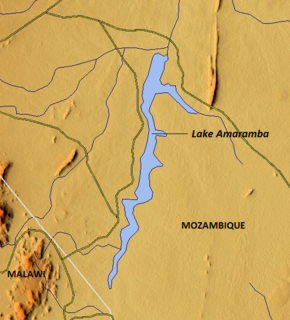
Lake Amaramba is a shallow lake in Mozambique, near the border with Malawi. Located in the Nyasa plateau, it is north of Lake Chiuta. The lakes are separated by a sandy ridge and a channel links the two lakes. On the western side of the channel, the connecting waterway is known as the River Msambiti while on the eastern side, it is known as the Lugenda River. Lake Amaramba is intermittently linked to the Lugenda River, a tributary of the Ruvuma River.

The Mtwara–Mbamba Bay Road, also A19 Road, connects the city of Mtwara on the Indian Ocean coast, to the town of Mbamba Bay on the eastern coast of Lake Malawi. It is a busy and important transport corridor in the southern regions of Tanzania. It is also an integral part of the Mtwara Development Corridor that spans four Southern African countries; Malawi, Mozambique, Tanzania and Zambia.

The Mtwara Development Project is a major infrastructure development project involving southern Tanzania, northern Mozambique, eastern Malawi and Eastern Zambia. The goal of this project is to provide road, rail and waterway access from the surrounding region to the Port of Mtwara. The region and the corridor has been neglected by the respective governments for over 40 years and the recent discovery of oil, gas and various minerals has kick started the development of the project. A road and rail link is to be built from the port of Mtwara to Mbamba Bay on Lake Nyasa to link Malawi to the corridor and further road links into Mozambique will facilitate access to northern Mozambique.

Tanzania–Mozambique relations are bilateral relations between Tanzania and Mozambique.

The Njesi Highlands are a range of mountains in northern Mozambique.

Mount Mecula is a mountain in northern Mozambique. It is located in Niassa Province, near the center of Niassa National Reserve.
